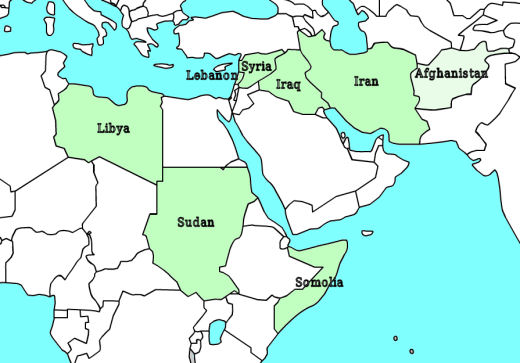Neo-Con Dreams
by MaryWe’ve always known that when George W. Bush launched his preemptive war against Iraq, the public reasons and excuses for war were a mere cover for the actual reasons the neo-cons wanted war. In 2003, the American Public thought that the war was for: 1) Saddam was seeking to create weapons of mass destruction, 2) Saddam was behind 9/11 and 3) Saddam was an ally of Osama bin Laden. However, the invasion of Iraq was always about more than "the central front on the war on terror", it was the first step on the way to creating the American empire. Now there is even more proof that this was true.
Many in the Bush administration were eager to invade Iraq immediately following the September 11 attacks, regardless of who was later deemed to be responsible. This is well-known. What’s gotten less attention are claims, made by Wesley Clark in 2003, that Iran, Syria, Libya, Sudan, Somalia and possibly Lebanon were on the hit list as well. New credence has now been given to these claims – credence that comes from examining passages in Douglas Feith’s recent book War and Decision.
In the book, Feith wrote of the September 30, 2001[1], memo from Rumsfeld to President Bush advocating "new regimes" in some states — in quoting from the document, Feith mentions Afghanistan but deleted the rest of the list, putting "some other states" in brackets, seemingly as an irrelevant aside.
So the enterprising historian Gareth Porter did what, apparently, nobody deigned to do: he simply asked Feith what other states the Secretary of Defense proposed invading. Feith declined to say, for national security reasons, what the states were — but the wily Porter pressed on, asking Feith what countries on Clark’s list were in the document. Feith acknowledged, "All of them." (And this guy had a security clearance?)…
WASHINGTON, May 5 (IPS) – Three weeks after the 9/11 terror attacks, former U.S. Defence Secretary Donald Rumsfeld established an official military objective of not only removing the Saddam Hussein regime by force but overturning the regime in Iran, as well as in Syria and four other countries in the Middle East, according to a document quoted extensively in then Undersecretary of Defence for Policy Douglas Feith’s recently published account of the Iraq war decisions.
…Rumsfeld’s paper was given to the White House only two weeks after Bush had approved a U.S. military operation in Afghanistan directed against bin Laden and the Taliban regime. Despite that decision, Rumsfeld’s proposal called explicitly for postponing indefinitely U.S. airstrikes and the use of ground forces in support of the anti-Taliban Northern Alliance in order to try to catch bin Laden.Instead the Rumsfeld paper argued that the U.S. should target states which had supported anti-Israel forces such as Hezbollah and Hamas. It urged that the United States "[c]apitalize on our strong suit, which is not finding a few hundred terrorists in caves in Afghanistan, but in the vastness of our military and humanitarian resources, which can strengthen the opposition forces in terrorist-supporting states."
Feith describes the policy outlined in the paper as consisting of "military action against some of the state sponsors and pressure – short of war – against others".
The Rumsfeld plan represented a Pentagon consensus that included the uniformed military leadership, according to Feith’s account. He writes that the process of drafting the paper involved consultations with the outgoing Chairman of the Joint Chiefs of Staff Gen. Henry Shelton and the incoming Chairman Gen. Richard Myers…

It was supposed to be easy. Iraq was first on the long list of countries that would be violently yanked into America’s list of vassels. Saddam was seen as weak and a suitable object lesson. Altercation asks a frightening question: What if Iraq had gone well? In that case, how many countries would we have invaded already? One other point. If John McCain is elected president, the neo-con dreams would continue unabated as voting for McCain would be seen as a total vindication of the neo-con’s approach to foreign policy…
[…] decision made by George Bush. And then there’s the unreleased Rumsfeld September 30, 2001 Memo that apparently list a number of targets. As my father was known to repeat endlessly, "I […]